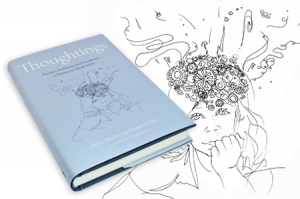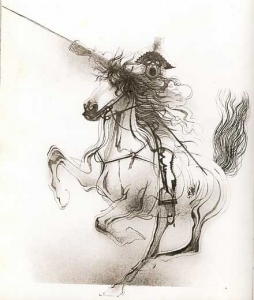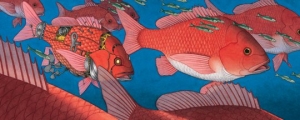Peter Worley | Getting Deeper with Poetry

In 2012 Andrew Day and I published a collection of poetry called Thoughtings and in 2014 I wrote two blog entries around poetry called Why Poetry? and How to use poetry for philosophical enquiries. I still use Thoughtings and the methods and approaches described in the blogs, but I have developed an approach that helps us get deeper with poetry. When I have run training with teachers on poetry and we go through the problems faced, metaphor with young children regularly comes up. If you take a look at Thoughtings, one thing you’ll notice is the lack of metaphor and symbolism in any extended way (‘Déjà vu’, ‘Asteroid’ and ‘Lines’ being among the exceptions). This was in order to make the questions of the poems more accessible to younger audiences. Interestingly – rightly or wrongly – Thoughtings was critiqued by one poet as ‘not proper poetry’ because of the lack of ‘metaphor and symbolism’. Whatever you think about that, metaphor is an important part of poetry, so I have always been on the look out for ways to get children to be able to more successfully penetrate metaphor. Therefore, in addition or alternatively to the approaches described in the previous ‘poetry’ blogs, here’s a tried-and-tested way (or two) to have children approach metaphor, symbolism and interpretation that I’ve developed for use in philosophy sessions but which can also be used for a variety of literacy purposes. Key to this approach’s success is that you are able to have the children tackle metaphor without their first having to explicitly understand it. I call this method ‘The Concept Box’ and it was first written about in Once Upon an If: The Storythinking Handbook (Bloomsbury 2014) page 77. Here I describe it only in the context of poetry but it works just as well for stories and images too.
- Present the stimulus (read the poem) – see previous blog ‘How to use poetry for philosophical enquiries’ for more details on how to read poems effectively (the use of hand gestures and facial features etc.)
- Unpack words and phrases – See previous blog ‘How to use poetry for philosophical enquiries’, particularly steps 1-4.
- Concept fishing – ask the children to each come up with a single word that they think the poem is about. In order to encourage diversity and breadth, here you may prefer to stipulate that they each come up with a different word from the others. Write the words up on the board for all to see clearly. Hint: It can sometimes be helpful (especially if doing philosophy) to reformulate contributions perhaps into noun-form or verbs into their infinitive-form, so, ‘adventurous’ becomes ‘adventure’, ‘confused’ becomes ‘confusion’ or ‘being confused’, and ‘happy’ becomes ‘happiness’. Again, only do this where it helps to do so. This can help the contributions to be concept-focused. (‘Concept-fishing’ is a strategy I have borrowed from Grace Robinson of Thinking Space: www.thinkingspace.org.uk)
- Concept funneling – ask the children to look at and consider the words collected on the board, then ask them to choose just one from all the words that they think captures what the poem is ‘really’/’mainly’/’importantly’ about. Start by gathering between 3 and 7 central concept-words. You may also do this section by asking the children to cross words off that are less central to the story.
- Critically engage the class – do they agree with words that have been chosen? Would they choose another one? Maybe they would like to introduce a completely new word? This step is the tricky bit and needs a little more saying about it. This section can lead to abstract or concrete discussions (see Tim Sprod's recent TPF blog for more on this). For instance, ‘We shouldn’t have ‘romance’ and ‘love’ because they are both the same’ which leads to an abstract discussion about whether ‘romance’ and ‘love’ are the same (one girl said, in answer to this very question, ‘They are not the same because I love my cat but I don’t cook it a meal, dim the lights and put nice music on!’ Everyone laughed). Or, you could ask ‘Can you show me, in the poem, why it’s not about love?’ which asks for concrete textual evidence for a key-concept choice. This is very important to make use of, especially if you want to refer to the poem specifically for your lesson-plan purposes. (See also the Hokey Kokey method) for how to move between the abstract and the concrete in order to make progress in these kinds of discussions.) In Once Upon an If I suggest some ways that the concept-words can be used to pursue lines of enquiry:
- Justify – Question: ‘Could you say why the poem is about X?’
- Clarify – ‘Can you say what you mean by X?’
- Challenge – ‘Is there anyone who thinks that the poem is not about X?’
- Distinction – ‘Are there different kinds of X?’
- Compare – ‘Is X the same as Y?’, ‘In what way is X different from Y?’
- Connect – ‘Are X and Y in any way linked?’
- Textual analysis – ‘Can you show, in the poem, why you think the poem is about X?’ (For this it is sometimes useful to have a copy of the poem available for the children to be able to refer to)
- Look out for any questions that emerge during this procedure that you could use for an enquiry (whether philosophical or not).
Broadly, the ‘fishing’ process broadens out to capture a variety of ideas and might be represented like so:
<
The ‘funnelling’ process narrows in to focus on particular, central concepts and might be represented like so:
>
Together they form an oblique ‘box’:
<>
Hence, ‘the concept box’.

Poems I have used this approach with successfully, include:
- The Highwayman by Alfred Noyes
- The "Veggy" Lion by Spike Milligan
- Lines by Peter Worley (see Thoughtings)
- Between My Ears by Peter Worley (see Thoughtings)
Stories include:
- It by Peter Worley (see Once Upon an If)
- Flotsam by David Wiesner (wordless texts work really well with this approach)
- Icarus (Greek myth)

I have also used this successfully with the National Gallery’s ‘Take One Picture’ project: http://www.takeonepicture.org/ where the teacher and I combined Visual Thinking Strategies (VTS) with The Concept Box. Go here for more on VTS: http://www.vtshome.org/
The Concept Box works well with adults (I’ve used it with philosophers or teachers I’m training). To demonstrate the method’s effectiveness I always choose a poem that is ‘difficult’ for the audience to interpret so that they can better see how it might work with children. For this purpose I have used ‘The Song of Wandering Aengus’ by W.B. Yeats.
The following new collection is a wonderful collection to work from for using the concept box approach:
Shreds and Patches by Oliver Leech.
Click the link below for a free downloadable resource containing a selection of poems taken from this book by Oliver.
Posted by on 3rd October 2016 at 12:00am
Category: Poetry, Philosophy, P4C, Education




